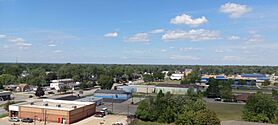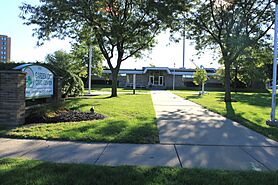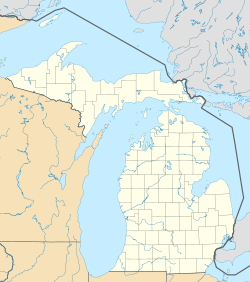Garden City, Michigan facts for kids
Quick facts for kids
Garden City, Michigan
|
|
|---|---|
| City of Garden City | |
|
Clockwise: Aerial view of Garden City, Downtown Welcome sign, Former Arnold Folker residence, Garden City City Hall
|
|

Location within Wayne County
|
|
| Country | |
| State | |
| County | Wayne |
| Incorporated | 1927 (village) 1933 (city) |
| Government | |
| • Type | Mayor–council |
| Area | |
| • City | 5.86 sq mi (15.18 km2) |
| • Land | 5.86 sq mi (15.18 km2) |
| • Water | 0.00 sq mi (0.00 km2) |
| Elevation | 633 ft (193 m) |
| Population
(2020)
|
|
| • City | 27,380 |
| • Density | 4,669.96/sq mi (1,803.21/km2) |
| • Metro | 4,285,832 (Metro Detroit) |
| Time zone | UTC-5 (EST) |
| • Summer (DST) | UTC-4 (EDT) |
| ZIP code(s) |
48135, 48136
|
| Area code(s) | 734 |
| FIPS code | 26-31420 |
| GNIS feature ID | 0626632 |
Garden City is a city in Wayne County, Michigan. It's a western suburb of Detroit, about 15 miles (24 km) west of downtown. In 2020, about 27,380 people lived there. Garden City is famous for being the home of the very first Kmart and Little Caesars stores.
Contents
History of Garden City
The story of Garden City began in October 1835. A man named John Lathers received 160 acres (0.65 km2) of land from Andrew Jackson. The city was designed using a special idea called the "garden city" concept. This idea was popular in England in the 1800s.
Early Design and Growth
The original plan for Garden City was to have most homes on 1-acre (4,000 m2) plots. This allowed families to grow their own fruits and vegetables. Today, most lots are much smaller. Some are as tiny as 40 feet by 135 feet. This leaves little space for large gardens. However, some older streets still have bigger lots.
In June 1927, Garden City became a village within Nankin Township. Arnold Folker was the first Village President. Six years later, in 1933, the village officially became the City of Garden City.
Famous Firsts and Landmarks
Garden City is known for several "firsts." The very first Kmart store opened here in 1962. It closed in 2017 and was later torn down. The first Little Caesars pizza place also opened in Garden City in May 1959. It was located at 32594 Cherry Hill Road and closed in 2018. Michigan's first dine-in McDonald's was also in Garden City.
The Folker Building was the city's first city hall. It is a gray stone building at Ford and Middlebelt Roads. Later, it held shops like Orin Jewelers. A new city hall was built on Middlebelt Road. The small house where Henry Ford and his wife, Clara Jane Bryant, spent their honeymoon was moved to Garden City in 1952. It came from Dearborn.
Geography of Garden City
Garden City is located entirely on land. It has a total area of about 5.87 square miles (15.20 km2). There are no large bodies of water within the city limits.
Population of Garden City
| Historical population | |||
|---|---|---|---|
| Census | Pop. | %± | |
| 1930 | 2,081 | — | |
| 1940 | 4,096 | 96.8% | |
| 1950 | 9,012 | 120.0% | |
| 1960 | 38,017 | 321.8% | |
| 1970 | 41,864 | 10.1% | |
| 1980 | 35,640 | −14.9% | |
| 1990 | 31,846 | −10.6% | |
| 2000 | 30,047 | −5.6% | |
| 2010 | 27,692 | −7.8% | |
| 2020 | 27,380 | −1.1% | |
| U.S. Decennial Census | |||
The population of Garden City has changed over the years. In 1930, there were just over 2,000 people. The city grew a lot in the mid-1900s. By 1960, the population was over 38,000. In 2020, the city had 27,380 residents.
Population Details (2010)
In 2010, there were 27,692 people living in Garden City. There were 10,894 households. About 31.7% of these households had children under 18. The average age of people in the city was 39.9 years old. About 22.4% of residents were under 18.
Education in Garden City
The Garden City School District provides education for students in the city. The district has several schools. These include four elementary schools and one middle school. There is also a public high school. This high school has a performing arts center and a swimming pool. An alternative high school, Cambridge High School, is also part of the district.
School Changes Over Time
During the "baby boom" years, a second high school was built. It was called Garden City West High School. Its sports teams were known as the Tigers. At that time, Garden City High School became Garden City High School - East. Its teams were the Panthers.
Later, as student numbers changed, Garden City West became Garden City Middle School. Four other middle schools (Burger, Radcliff, Vogel, and Cambridge) were closed. Burger Middle School is now Burger Baylor School. It serves students with autism. Radcliff Middle School became a campus for Schoolcraft College. The city now uses that building for its Parks and Recreation Department. Vogel Middle School was torn down. Cambridge now serves as the district's alternative high school. After these changes, Garden City East went back to being called Garden City High School. Its teams are now known as the Cougars.
Tipton Academy is another school in Garden City. It is a charter school for students from pre-kindergarten to 7th grade. St. Raphael Catholic School in Garden City closed in 2016.
See also
 In Spanish: Garden City (Míchigan) para niños
In Spanish: Garden City (Míchigan) para niños






